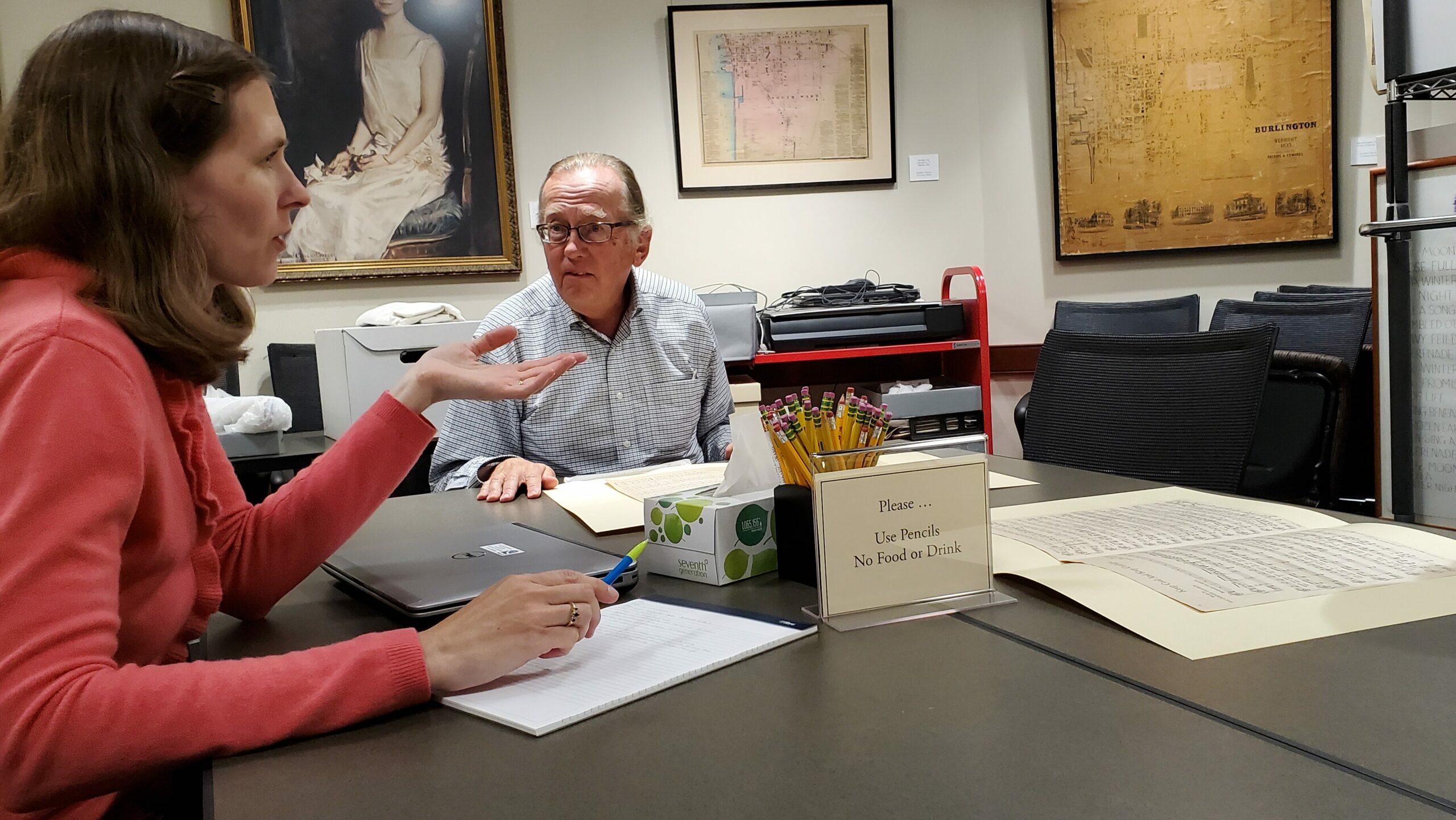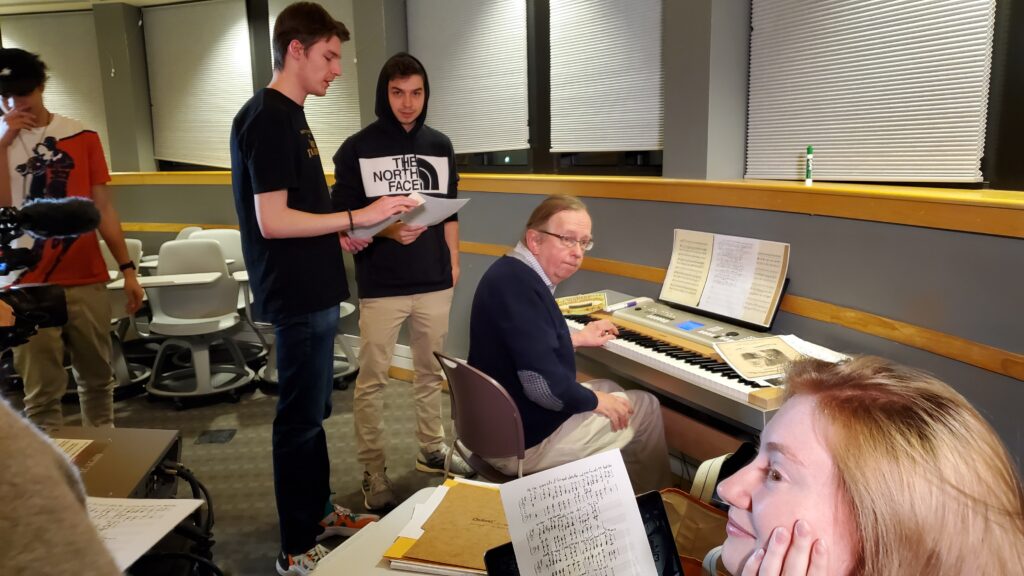Popularity Contest: Museum Music, or Songs That Live Forever
Essay By Wayne Schneider, Ph.D., professor emeritus of music history, University of Vermont April 2020
In 2014, Champlain College hosted a gala evening in Roger H. Perry Hall, featuring performances of selected vintage popular songs from its Lance Llewellyn Collection of Vermont History. Bill and Mindy Bickford sang the songs, and I accompanied them on the piano. I also made a few remarks on the pieces we performed, and on popular music generally. Erica Donnis, archivist of the Collection, organized the event. The Bickfords and I enjoyed performing the music, and the event was successful.
I am pleased that now six years later a Champlain College student, Travis Washington, has taken a more scholarly interest in the song collection, studying the cultural context of this music, creating a filmed documentary, and incorporating performances of selected songs by the college a cappella group Purposeful Dissonance. Erica Donnis invited me to be a consultant on the project, and, moreover, asked me once again to offer some remarks. In this season of pandemic, however, instead of the planned festive evening of film and performance and commentary, I must contribute my observations via Travis’s website devoted to the project––a website I know will add to the understanding of the Llewellyn Collection and its Vermont music.
I thank Erica again for asking me to participate and for her tireless support of this project, the Llewellyn Collection, and Champlain College’s library in the Miller Information Commons.
The title of this essay is “Popularity Contest: Museum Music, or Songs That Live Forever.” Big title. Big topic. Permit me to take a somewhat roundabout approach, and begin with some autobiography.

I was a radio kid. I grew up in Cedar Falls, Iowa, a small university town and a small twin city to Waterloo, Iowa, a large industrial city. Waterloo was home to Rath meatpacking company, and still is home to the world’s largest tractor manufacturing plant, John Deere. In the 1930s and especially during WWII, a large population of African-Americans migrated to Waterloo, seeking work in these two industries. The consequent thriving African-American population, segregated, of course, in Waterloo’s East Side, supported late-night programming on Waterloo’s big radio station: KWWL. KWWL played white rock and roll and current popular music during the day. But late at night, the station’s musical world changed. My parents weren’t too crazy about me staying up to listen to KWWL’s late-night fare––something about the music being “too adult”–– admonitions that, naturally, encouraged me. That forbidden music was enthralling. Jazz, blues, and especially R-&-B. I also listened to the Cedar Falls station, KCFI, where––stranger than fiction but true––I was a weekend disc jockey for a few years. KCFI played “sweet” pop music. But, thinking back, I believe I heard about every conceivable kind of pop music out there.
Today I am a retired professor of music history and a classically-trained keyboard player, but I have never lost my love for popular music. I wrote my Ph. D. dissertation on George Gershwin, the great American popular song composer and composer of operas, a piano concerto, orchestral music, a string quartet, and more. I think the choice of subject reflected my ongoing interest in popular and classical music and their intersections, or collisions, in particularly American music.
So much for autobiography. So I am a fan of popular music; I suspect we all are. But what about the title of this essay? What exactly is popular music and what is its value?

You might have guessed that there is a problem with the definition of popular music. Incidentally, I am not talking about folk music, which is part of a “tradition,” the composer of which is uncertain or irrelevant. Folk music has an archaic, but timeless style and effect. “Barbara Allen” and “Black Is the Color of My True Love’s Hair” sound fresh and resonate beautifully today as they have for centuries. And I am not talking about classical music either, which does indeed have a composer, and is timeless as well. Moreover, just to confuse the issue, of course there are popular folk songs and popular pieces of classical music––popular in the quantitative sense. But popular music, popular songs, the music which is showcased in the Llewellyn Collection and studied in this project, are, rather than timeless, timely: locked into their historical context, their time. For example, most listeners consider 1970s disco to be dead, 1950s and ’60s rock and roll sounds a bit naive, nightclub songs of the 1940s and ’50s sound dated, popular songs of the Roaring Twenties can sound corny, and so on. Popular-music performers, too, have a shelf life. Oddly enough, in their day, great pop-music performers often are held up by polite society as musical Armageddon, the breaking down of moral decency, the End of the World: Sinatra in the ’40s, Presley in the ’50s, the Beatles and Rolling Stones in the ’60s, performers of the “too adult” music on KWWL, and so on. During my years teaching at UVM, I offered writing seminars for freshmen, many assignments of which encouraged critical listening and evaluation of current popular music. Now, clearly, the “scene” in popular music today is far more fragmentary than in my youth. Back then (when the earth’s crust was still warm), the pop- music industry had a weekly Top 40, supported by Billboard magazine and promoted by disc jockeys on radio and television shows like American Bandstand. But I discovered in my students’ essays how deep passions still run for listeners of contemporary popular music––in whatever stylistic niche. Students leveled extraordinarily vitriolic prose assessments against the perceived Great Sell-Outs, changing, of course, over the decades of my teaching: Madonna, Britney Spears, Jonas Brothers, Taylor Swift, Eminem, Justin Bieber. I remember reminding students that what they were so mad at was––pure and simple––music, and listening to Taylor Swift had to be less painful than a root canal. But the lesson was learned: people are passionate about the popular music they listen to––especially when they are young. And like the songs, the performers fade, too, and their diabolic behaviors seem harmless.
These … songs are really tiny time capsules from eras gone by, windows into the souls of Americans, of Vermonters of generations past. We hear in the songs universal human strivings and aspirations. Again, we hear love, certainly, but also loss, struggle, nostalgia, quirky humor, religious piety and hope, patriotism, and more.
However, popular music, even though ephemeral, is important; it has its time, it has its place. Not only is this music “popular” in the quantitative sense––the music sells, and may be very well known indeed, as I mentioned above––but also “popular” in the qualitative sense: music of the people. American popular music somehow strikes a responsive chord in the listener; it resonates in the hearts of Americans. We all have memories of favorite popular songs––songs that mean something special to us. Love songs (a first kiss, prom night), funny songs, songs we just can’t seem to forget. These musical sins––often, again, from our youth––are part of our make-up. I confess I remember all the words to “Chantilly Lace” (the Big Bopper), “The Witch Doctor (Oo Ee Oo Ah Ah),” “The Purple People Eater,” and, yes, “Itsy Bitsy Teeny Weeny Yellow Polka-Dot Bikini.” I offer no defense for these musical memories; I am scarred for life. But I am not the only sinner in the room. Is “Rapper’s Delight” on anybody’s top ten list? what about Salt-N-Pepa? or Ice-T, Geto Boys, or even the late Tupac Shakur? Will Beyoncé, Drake, Rihanna, Meghan Trainor, Kesha, Halsey, Selena Gomez, Billie Eilish, Lizzo, and Post Malone––among seemingly zillions of others––drift into historical obscurity? Probably. (Incidentally, full disclosure: I know maybe half of the musicians on this last list; I found them in a review of new pop music in Time magazine. Who can keep up?)

The music showcased on Travis’s website features American popular songs from the Llewellyn Collection, songs about Vermont and by Vermonters from maybe a hundred-year span: mid-nineteenth century to mid-twentieth century. The songs are typical of their time: patriotic songs, songs commemorating important events in the state’s history, dialect songs, novelty songs, nostalgic songs about loss, and, of course, love songs. Most of these songs, typically too, are cast in simple form: introductions, verses, and refrains. The harmonies move straightforwardly, often in the barbershop “how dry I am” style. The lyrics are clichéd, but to the point.
Really old songs, most of them. Dated, we might say. Locked in time, like fossils in amber. But are these songs important in any way? Can we learn anything from these old “corny” tunes and texts? (Remember and be warned: our absolutely most favorite songs will probably age about as well as we do!)
So here’s my point, finally. I have spent a good deal of my youth and professional life listening to and studying American popular songs from all eras. Hence, the rambling autobiographical introduction. These Llewellyn songs are really tiny time capsules from eras gone by, windows into the souls of Americans, of Vermonters of generations past. We hear in the songs universal human strivings and aspirations. Again, we hear love, certainly, but also loss, struggle, nostalgia, quirky humor, religious piety and hope, patriotism, and more. I believe a common thread runs through these songs, what I listened to on the radio in Iowa, and what’s going on out there today.
Much––not all, I emphasize––of today’s pop music, seems to me, is deeply confessional, outlining anxieties, fears and pain: a new generation using popular art as a way to understand and cope. Pandemics, the threats of climatic, economic, and political instability leech into haunted lyricism and nihilistic tunes and performers. Introspective and dark music existing cheek by jowl with brighter, more hopeful songs. But popular music is as it has always been: music of the people, music of its time. It reflects us now, as it reflected us in the past. It tells us part of our story, our history: who we are and who we were.
Keep listening! Enjoy the website!